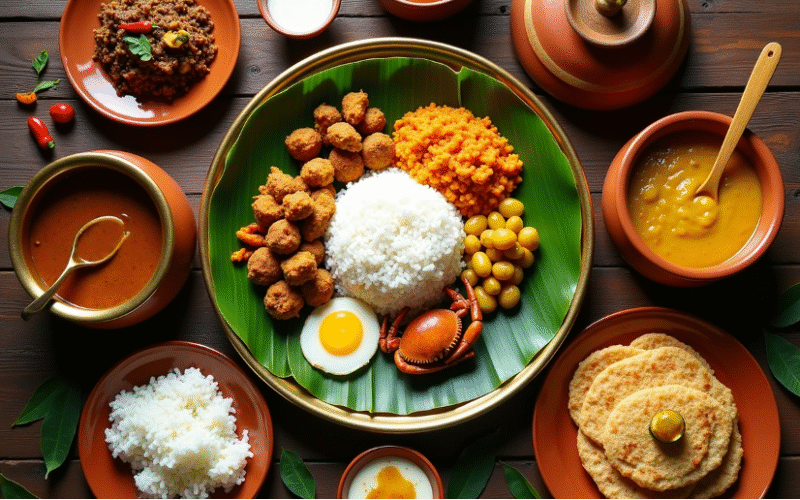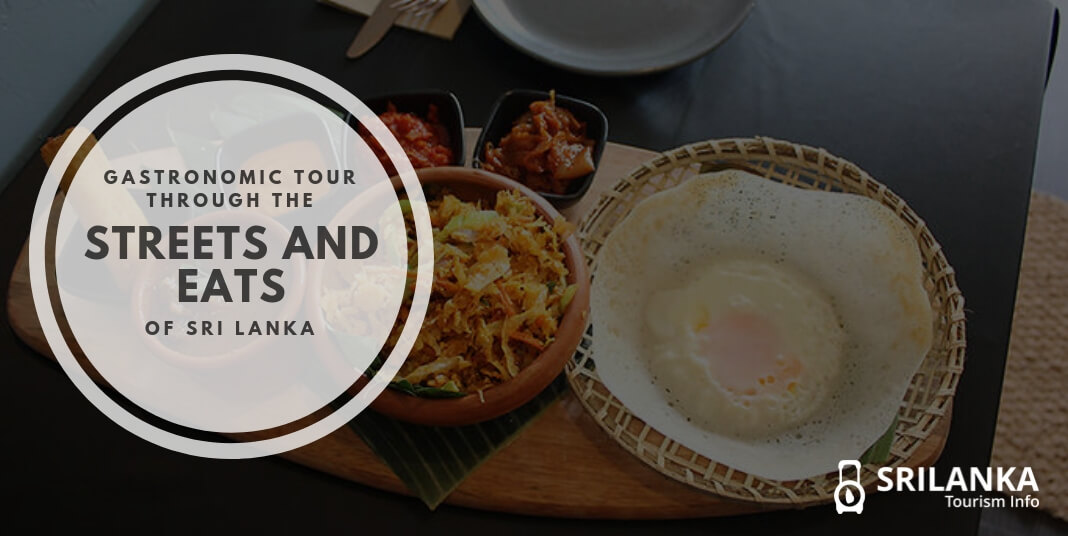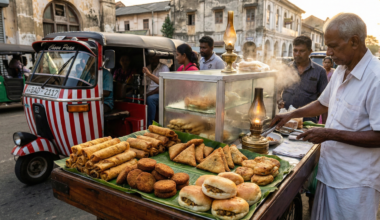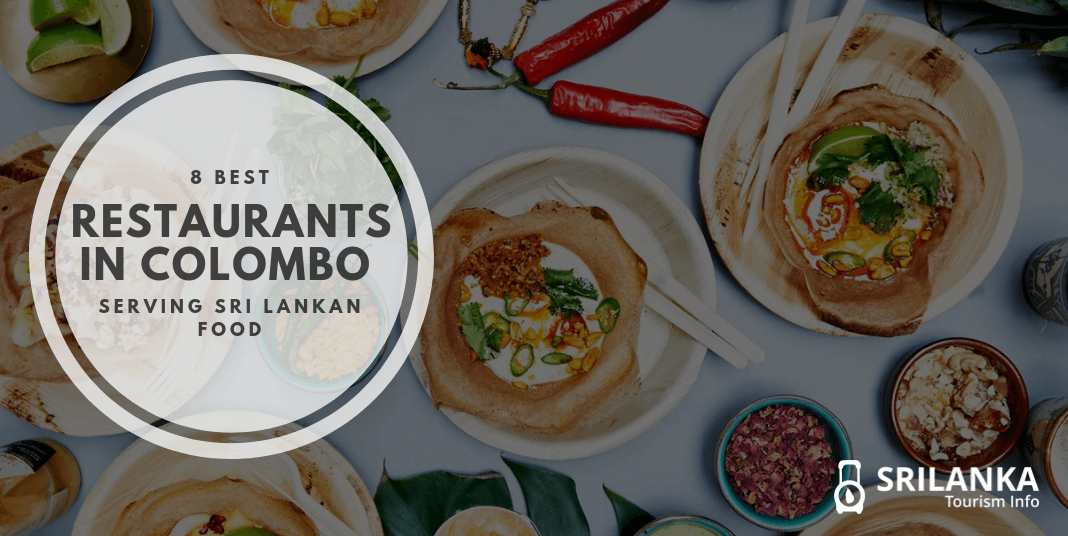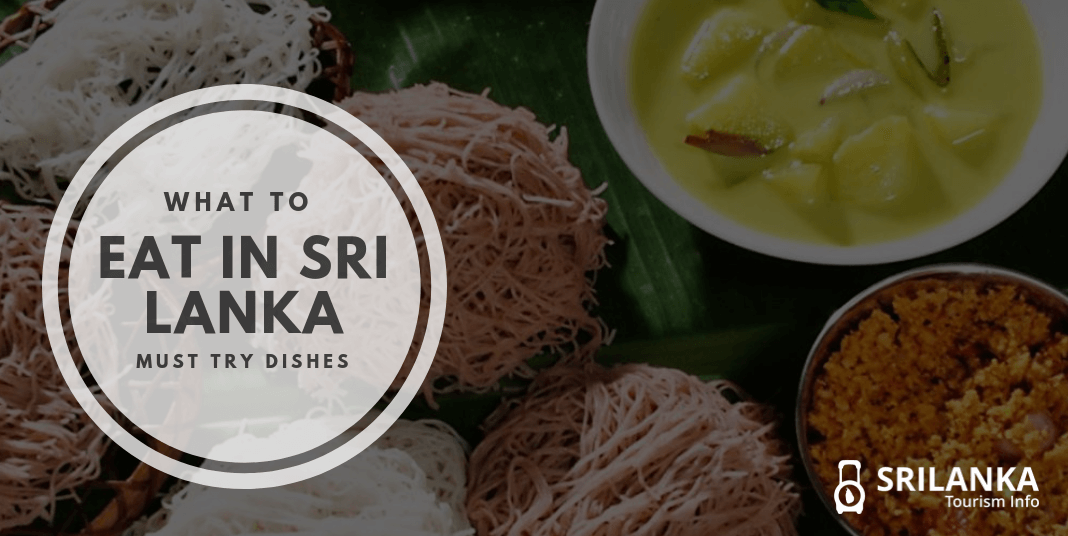Sri Lankan food is a culinary playground filled with vibrant flavors. A giant meal costs just $1-$2. The island nation’s distinctive cuisine will take you on an amazing taste adventure.
Sri Lankan dishes share similarities with South Indian food but maintain their own identity. The country’s rich blend of culinary influences began with the Portuguese arrival in 1505. Coconuts and fish remain two of its most important ingredients. Sri Lanka’s impressive comeback on the global stage brought millions of tourists in 2024. The food scene excites taste buds and welcomes both vegans and vegetarians. Traditional dishes slow-cooked over fire in earthen pots showcase the cuisine’s depth. Quick snacks like short eats from roadside stalls cost as little as 50 LKR ($0.30 USD) each. The variety will amaze you.
This tropical paradise has essential flavors waiting to be experienced. Let me show you 10 must-try Sri Lankan foods and the best places to find them in each city.
Kottu Roti
The metallic clanging of blades against a hot griddle announces Kottu Roti before you even see it. This iconic Sri Lankan street food has become a national favorite that surpasses all socioeconomic boundaries.

Image Source: South East Asia Backpacker
Kottu Roti description
The dish emerged in Sri Lanka’s Eastern province during the 1960s-70s as an affordable meal for workers. “Kottu” means “chopped” in Tamil, which perfectly describes how it’s prepared.
This tasty dish combines chopped godamba roti (a type of flatbread) with meat curry (chicken, beef, mutton, or seafood), scrambled eggs, vegetables, and aromatic spices. The magic happens on a large flat iron griddle, where cooks use two metal blades to chop, mix, and pound everything together. Kottu started as a smart way to use day-old roti, turning leftover bread into something special. These days, you’ll find several popular versions:
- Vegetable Kottu (for vegetarians)
- Cheese Kottu (a modern favorite)
- Egg Kottu (without meat)
- Seafood Kottu (featuring fish or crab)
Best place to try Kottu Roti
Hotel de Plaza on Galle Road serves authentic Kottu in Colombo. This 24-hour spot draws locals from journalists to advertising executives who love its famous cheese beef kottu. A meal costs between Rs.350-450 per person – great value for authentic flavors.
Hotel De Pilawoos makes exceptional seasoned Kottu varieties. The prices run slightly higher (Rs.400-500), but the unique taste makes it worth every rupee. Travelers in Ella should check out Wimala Restaurant for excellent Kottu at local rather than tourist prices.
Ali Restaurant & Cool Spot in Arugam Bay stands out because the owner makes fresh roti for each order. You’ll get a hot, fresh meal instead of one made with pre-prepared roti.
Why Kottu Roti is a must-try
Kottu Roti offers more than just great taste – it’s a full sensory experience of Sri Lankan culture. The rhythmic sound of metal blades hitting the griddle creates a street symphony that defines Sri Lankan nightlife. Watching the cooks work is entertainment itself. Each vendor creates their own beating rhythm that turns cooking into performance art.
Kottu shows Sri Lankan culinary creativity by turning basic ingredients into something extraordinary through technique and flavors. Late-night crowds love it, and it’s gained fame as an ideal hangover cure thanks to its perfect mix of carbs, protein, and spices. A trip through Sri Lanka isn’t complete without trying this street food sensation that delights all senses – from its musical preparation to the burst of flavors in every bite.
Egg Hoppers (Appa)
Sri Lankan kitchens buzz with activity at dawn as cooks prepare Egg Hoppers (Appa) – bowl-shaped pancakes that are the crown jewels of the country’s breakfast cuisine. These crispy-edged treats with soft-cooked eggs catch your eye instantly and leave a lasting impression with their taste.

Egg Hoppers description
A freshly cracked egg sits in the center of these thin, bowl-shaped pancakes. The batter blends fermented rice flour, coconut milk, yeast and a hint of sugar to create its unique texture. The mixture sits overnight to ferment, which gives it a slight tang.
The cooking brings the magic to life. Cooks pour the batter into special rounded hopper pans that look like tiny woks and swirl it around to form thin, crispy edges with a softer center. The egg goes in just as the batter starts to set. A cover goes on top so the egg can steam-cook until the whites set, leaving the yolk perfectly runny.
Each hopper tells a story of contrasting textures. Crispy, lacy edges flow into a soft, spongy center that cradles a perfectly cooked egg. The subtle coconut notes complement the egg’s richness, making every bite just right.
Best place to try Egg Hoppers
Green Cabin, one of Colombo’s oldest eateries, serves excellent hoppers consistently. Walkers’ Café at Independence Square makes great hoppers too and serves them with amazing katta sambal, a spicy side dish.
Grand Oriental Hotel runs special “hoppers nights” on Fridays and Saturdays from 7:30-11:00 PM. Their all-inclusive buffet costs Rs. 750. The simple-looking Uva Hotel near Liberty Cinema surprises everyone with thick egg hoppers that come with generous sprinkles of pepper.
Travelers love CK Hoppershop in Hikkaduwa, a family-run spot where everything comes fresh from the kitchen. Hotel guests at Hilton and Cinnamon Lakeside in Colombo can enjoy excellent hoppers with plenty of sides.
Why Egg Hoppers are iconic
Sri Lanka’s food culture treasures egg hoppers, and with good reason too. They represent the country’s clever take on breakfast – nutritious, tasty, and beautiful to look at.
These hoppers show how important shared meals are in Sri Lankan culture. They come with various sides:
- Spicy sambols (chili-based condiments)
- Fragrant curries
- Creamy dhal
- Coconut gravy
Everyone can mix and match these sides to create their own perfect combination.
Egg hoppers mean more than just food – they embody Sri Lankan warmth and hospitality. Families pass down their hopper recipes through generations. Making hoppers brings family members together as they share meals and create memories.
These hoppers are a great way to get to know Sri Lankan food’s depth – from texture combinations to balanced flavors and artistic presentation that makes the island’s cuisine stand out.
Rice and Curry
The humble combination of rice and curry sits at the heart of Sri Lankan cuisine. This meal is so essential to daily life that locals skip asking “Have you eaten?” and instead say “Have you eaten your rice?”

Rice and Curry description
Rice and curry stands as the life-blood of Sri Lankan food. A typical meal features steaming hot, fluffy rice served with at least three (ideally five) different curry dishes. The main component consists of boiled or steamed rice paired with fish or meat curries and various vegetable, lentil, or fruit-based dishes.
The island’s farmers grow more than 15 varieties of rice. These range from tiny white translucent grains to long-grained basmati and the distinctive nutty red kakuluhaal. Each variety provides the perfect foundation for curry’s complex flavors.
The curries display amazing variety and fall into three main categories:
- Red curries (colored with chilies, typically spicy)
- White curries (made with coconut milk, usually milder)
- Black curries (using dark-roasted spices for rich flavor)
A genuine rice and curry meal comes with several side dishes: spiced sambols (especially coconut sambol), pickled fruits or vegetables, chutneys, mallung (stir-fried greens with coconut), and crispy papadums.
Best place to try Rice and Curry
Upali’s by Nawaloka offers an outstanding rice and curry experience in Colombo. The restaurant occupies a former residential home with views of Viharamahadevi Park. Diners can enjoy authentic dishes like kiribath (rice cooked in coconut milk) with spicy chicken curry.
Curry Pot serves an impressive selection of more than twenty different curries for breakfast. The menu features succulent chicken, young jackfruit (polos), rich coconut sambol, and hearty lentil curry. Prices range from Rs.500 for vegetable curry and rice to Rs.800 for fried chicken rice with curry.
Budget-conscious diners should check out Cafe 4 U. The restaurant’s chicken curry and rice costs Rs.380, while vegetable curry and rice is available for Rs.300.
Why Rice and Curry defines Sri Lankan cuisine
Rice means more than just food in Sri Lanka – it represents cultural identity. Ancient Sri Lankan rulers built reservoirs to capture rainwater specifically for rice cultivation. People have developed and preserved rice varieties for over 3,000 years.
The island’s ethnic communities—Sinhalese, Tamil, Muslim, and Burgher—each created their own versions of rice and curry, showcasing Sri Lanka’s multicultural heritage. These variations share a common thread that unites the nation’s cuisine.
Rice and curry demonstrates Sri Lanka’s mastery of balanced flavors. Each plate creates a perfect harmony of contrasting tastes and textures – spicy curries balance with cooling coconut milk, crisp papadums complement soft rice, and tangy pickles enhance rich meat dishes. This beautiful blend of diverse elements mirrors Sri Lanka’s rich cultural tapestry.
Pol Sambol
Pol Sambol means everything to Sri Lankans – it’s not just a condiment, but a national obsession that captures the essence of the island’s food culture. The locals will tell you this vibrant coconut mixture ranks at the top of their comfort food list.

Image Source: Cooking The Globe
Pol Sambol description
Pol Sambol (coconut sambol) is a traditional no-cook condiment that blends freshly grated coconut with red onions, dried chilies, lime juice, salt, and sometimes Maldive fish. This versatile side dish creates a perfect balance of flavors – you get spicy, sweet, tangy, and salty in one bite. The creamy coconut base mixed with fiery chilies, zesty lime, and crunchy shallots creates what people call a “flavor explosion.”
The traditional method needs you to pound or grind these ingredients until they form a mix with a bright reddish-orange color. You’ll find some regional twists, like the “white” coconut sambol that uses green chilies instead of red ones. The best part? You can make it in under 10 minutes.
Best place to try Pol Sambol
Sri Lankan home kitchens serve the best Pol Sambol, where families pass down their secret recipes through generations. Tourists can still find great versions at restaurants that serve authentic Sri Lankan food.
Upali’s in Colombo serves amazing Pol Sambol with their rice and curry. Curry Pot makes a bright, flavorful version that goes well with their curry selection. The most authentic versions often come from small family-run places.
Pol Sambol tastes consistent across the country. From fancy restaurants to small roadside cafes, this popular condiment shows up on every Sri Lankan table and keeps its character whatever place you try it.
Why Pol Sambol is a staple
Pol Sambol has become a staple because it goes well with almost everything. It tastes great with:
- Rice and curry
- String hoppers (idiyappam)
- Hoppers (appa)
- Bread and roti
- Kiribath (milk rice)
The health benefits make it even better. Coconut gives you fiber, potassium, and healthy fats. Red onions pack quercetin that fights free radicals. Chilies add vitamins A, C, and K, while lime helps digestion and boosts vitamin C levels.
Pol Sambol shows what Sri Lankan cooking is all about – simple, rustic ingredients that turn into something special through balanced flavors. Sri Lankans miss it most when they travel abroad. A Sri Lankan food writer put it best: “Pol Sambol is the most Sri Lankan of all Sri Lankan dishes.”
String Hoppers (Idiyappam)
String Hoppers (Idiyappam) are a beloved breakfast staple in Sri Lanka. These delicate, lacy nests of steamed rice noodles represent the heart of the island’s culinary heritage.

Image Source: en.wikipedia.org
String Hoppers description
String hoppers, known locally as Idiyappam, start their journey as rice flour. Cooks press this flour into thin noodle-like strands and shape them into flat, circular mats before steaming to perfection. The magic begins with steamed wheat flour or roasted rice flour dough. A special mold transforms this dough into distinctive thread-like noodles. These noodles then take shape as circular weaves on mini wicker mats before steaming.
You’ll find two main types of string hoppers. White rice flour creates smooth, delicate textures, while red rice flour produces a heartier bite. Making these treats needs specific tools. String hopper molds, mats, and steamers are accessible to more people throughout Sri Lanka.
Best place to try String Hoppers
Culture Colombo stands out as a must-visit spot in Colombo. Their special tasting basket combines string hoppers with traditional sides and curry dishes. This makes a perfect introduction to Sri Lanka’s breakfast culture.
Back in the 1990s, a single serving of string hoppers cost just 10-20 rupees. Each portion came with coconut sambol and sometimes red lentil curry. String hoppers remain budget-friendly today. You can find them anywhere from local street vendors to luxury hotels.
Why String Hoppers are unique
String hoppers shine through their amazing adaptability. These steamed rice noodle disks differ from regular hoppers and work beautifully with both savory and sweet toppings.
Morning meals pair string hoppers with kiri hodi (coconut milk gravy) or mild curry. Evening diners enjoy them with richer chicken, fish, or beef curries. A classic string hopper meal always brings together:
- Coconut sambol or coconut mallum (pol mallum)
- Curry with gravy (commonly potato curry or red lentil curry)
- Sometimes spicy chicken curry or creamy fish curry
String hoppers mean more than just food to Sri Lankans. They represent comfort and home. One Sri Lankan living abroad shares how these treats became the most missed food from home. Making them became a regular ritual to reconnect with familiar tastes. This simple dish captures everything great about Sri Lankan home cooking. It’s affordable, satisfying, and brings comfort through its familiar textures and flavors.
Milk Rice (Kiribath)
Rice and coconut milk blend into a powerful symbol of auspicious beginnings in Sri Lankan homes. Milk Rice (Kiribath) brings together everyday nourishment and cultural ceremonies like no other dish can.

Image Source: CBC
Kiribath description
Rice cooked with thick coconut milk and a pinch of salt creates creamy, velvety texture that feels comforting and unique. This simple three-ingredient dish sets firmly after cooking, thanks to careful preparation.
Sri Lankan families traditionally cook kiribath in clay pots over earthen fires, though many now use modern cookware. The cooked rice mixture cools and sets on a flat surface—often a plantain leaf. People then cut it into diamond or square shapes before serving.
Kiribath shines in both sweet and savory combinations:
- Spicy lunu miris (chili paste), katta sambol, or various curries complement the savory version
- Ripe bananas, palm jaggery, or kithul treacle create sweet variations
Best place to try Kiribath
Family kitchens serve the most authentic kiribath with recipes passed down through generations. All the same, Curry Pot in Colombo offers excellent kiribath with traditional sides.
Local eateries called “hotels” serve kiribath to visitors, especially during morning hours. Market vendors sometimes offer homemade versions, giving tourists a glimpse into this beloved dish’s preparation.
Why Kiribath is culturally significant
Kiribath surpasses its role as regular food—it celebrates life’s key moments in Sri Lankan society. Rice and coconut represent prosperity in Sri Lankan culture, making kiribath the star of ceremonial occasions.
Sinhala and Tamil New Year celebrations in April showcase kiribath’s importance. Families make this dish at specific times chosen by astrologers, as it becomes the year’s first essential meal. The head of each family shares pieces with everyone, spreading prosperity.
Life’s big moments call for kiribath—weddings, birthdays, new jobs, and housewarming ceremonies. Parents even serve it as their babies’ first solid food. Wedding traditions include bridegrooms feeding kiribath to their brides.
Kiribath means more than just ceremony—it represents comfort and belonging. Sri Lankans living abroad make kiribath to reconnect with memories of home and family. This simple dish carries emotional weight way beyond its basic ingredients.
Jackfruit Curry (Polos)
Jackfruit Curry (Polos) stands out as one of Sri Lanka’s most remarkable vegetarian dishes. First-time visitors are often amazed by its meat-like texture and rich flavors. This traditional dish captures centuries of Sri Lankan cooking wisdom.

Image Source: Olive Magazine
Jackfruit Curry description
The heart of polos curry is unripe jackfruit (known as “polos” or “baby jackfruit” in Sri Lanka) that cooks until tender in a rich blend of spices. The traditional way takes time and effort – the young jackfruit slices simmer in a clay pot over an earthen fire at least six hours. The fruit soaks up a spice-rich coconut broth with cloves, cardamom, dried tamarind, and aromatic spices during this time.
The real wonder of polos curry shows in how it changes – the cooked jackfruit ends up with a texture that feels just like pulled pork. This meat-like quality has made jackfruit a hit worldwide as a plant-based protein option, though Sri Lankans have known this secret for generations.
The cooking starts with cutting young jackfruit (before it develops seeds) into chunks and mixing it with local spices, coconut milk, and curry leaves. Fresh jackfruit needs careful handling – it releases sticky sap that clings to hands and tools, but a bit of cooking oil helps remove it.
Best place to try Jackfruit Curry
Upali’s by Nawaloka in Colombo is a must-visit, where Chef Wasantha Ranasinghe serves both classic and creative jackfruit dishes. Lords Restaurant Complex in Negombo makes an amazing jackfruit arrack coconut curry that locals call “smooth and flavorful”.
The Tree’s Restaurant in Tangalle gives you the freshest curry possible – they pick jackfruit right from their trees when you order, and you can watch them make it from scratch.
Why Jackfruit Curry is a hidden gem
Polos curry brings together old traditions and new food trends in a special way. The meat-like texture isn’t new – Sri Lankans figured this out long before vegan food became popular. The curry also shows how Sri Lanka’s eco-friendly cooking uses every bit of this amazing fruit at different ripeness stages.
The health benefits are impressive too – jackfruit packs plenty of vitamin C, B6, and potassium. The sort of thing I love about this dish is how it shows Sri Lankan cooking at its best – taking a simple fruit and making it extraordinary through clever cooking and perfect spicing.
The whole experience comes together beautifully when you eat polos curry with hot rice or roti – it’s the kind of comfort food that makes Sri Lankan home cooking so special.
Crab Curry
Sri Lankan seafood cuisine has made crab curry its signature dish. Food lovers from around the world travel to the island’s coastal areas to experience this remarkable delicacy.

Image Source: Lakpura
Crab Curry description
The locals call it “Kakuluwo curry” or “Jaffna crab curry.” This beloved dish originated in the northern regions and has become popular throughout the island, especially in coastal areas. The recipe blends crab meat with lime juice, coconut milk, curry leaves, grated coconut, ginger, shallots, garlic, and essential spices like cinnamon, turmeric, and fenugreek.
The dish gets its distinctive taste when crabs slowly cook in a claypot. The meat soaks up the rich spice-infused coconut broth and creates a thick, flavorful gravy. Chefs use either blue swimmer or mud crabs and add drumstick tree seed pods (murunga leaves) to give it that authentic Sri Lankan touch.
Best place to try Crab Curry
Ministry of Crab in Colombo’s Old Dutch Hospital Complex serves what food experts consider the best crab curry worldwide. The Station Restaurant & Bar in Colombo has also earned praise for its authentic Sri Lankan crab dishes.
Travelers on a budget should check out Mayura Hotel. The locals love this spot for its excellent crab dishes that won’t break the bank. Cinnamon Hikka Tranz on Sri Lanka’s west coast serves outstanding mud crab curry. Their skilled chefs prepare it with fresh crabs caught off the coast daily.
Why Crab Curry is a seafood delight
This dish does more than just taste amazing. The crab meat packs high protein with minimal fat, making it better than many other protein sources. It also contains omega-3 polyunsaturated fatty acids that help keep your heart healthy.
Sri Lankan crab curry shows how the country’s chefs enhance natural seafood flavors without overpowering them. People usually enjoy it with rice, pittu or bread. Each mouthful combines sweet crabmeat, spicy curry liquid, and creamy coconut in what many call “a layered flavor bomb”.
Buffalo Curd with Treacle
A trip to Sri Lanka isn’t complete without tasting buffalo curd with treacle. This traditional dessert captures the island’s sweet culinary heritage in a simple earthen pot.

Image Source: SBS
Buffalo Curd description
Sri Lankans call it “Meekiri” or “Mee-Deekiri.” Buffalo curd has become deeply rooted in Sri Lankan food culture. The curd is thicker and creamier than regular yogurt. You’ll notice its pleasant texture and distinctive white color that sets it apart from cow milk yogurt.
The preparation starts with buffalo milk that simmers for two hours to reduce water content. Natural fermentation begins when a small portion of the previous day’s curd is added. The mixture cools to room temperature before being sealed and left for 12 hours to set overnight. Clay pots (“kiri hatti”) play a vital role in creating the curd’s authentic taste. Their porous nature provides natural insulation that makes all the difference.
Best place to try Buffalo Curd
The Treacle & Curd Shop serves traditional thick buffalo curd in mud pots topped with Palmyra tree treacle. Southern Sri Lanka’s Hangout Restaurant in Tangalle serves excellent locally made curd. Mirissa Eye in Mirissa offers this delicacy with a beautiful beachside view.
Why Buffalo Curd is a perfect dessert
Buffalo curd and kithul treacle create a perfect match. The treacle comes from boiled-down kithul palm sap. This thick, dark brown syrup tastes like dates with subtle caramel notes. The dessert strikes a perfect balance – the curd’s tanginess meets the treacle’s sweetness. Many people see these flavors as two parts of one amazing whole.
This sweet treat holds special meaning in Sri Lankan culture. People often serve it at Buddhist alms-giving ceremonies. The curd also packs natural probiotics and nutrients from the buffalo milk’s rich fat content.
Watalappan
Watalappan reigns as the crown jewel of Sri Lankan desserts. This rich coconut custard pudding beautifully showcases the island’s multicultural culinary heritage through its Malay influences.

Image Source: RECIPE30
Watalappan description
This cherished dessert features a rich egg custard with distinct ingredients that create its signature profile. Eggs mixed with creamy coconut milk give the dessert its silky texture, while kithul jaggery (palm sugar) adds its characteristic sweetness. The warming spices make this dessert special. We mainly used cardamom and nutmeg to give the custard its aromatic depth. The dessert develops light bubbles through traditional steaming instead of baking. Chopped nuts top the dessert and provide a nice crunch.
Best place to try Watalappan
Hana’s Watalappan has earned consistent praise for their homemade version in Colombo. Watalappan.lk delivers throughout Kaduwela with portions ranging from 80g (LKR 150) to full kilogram servings (LKR 1,500).
Why Watalappan is a must-have dessert
This dessert exceeds simple indulgence. It symbolizes cultural celebration and marks the end of Ramadan during Eid al-Fitr festivities in Sri Lanka’s Muslim community. Weddings, religious festivals, and special occasions now feature this beloved dessert. Kithul jaggery creates floral, woody and smoky flavors that make this dessert taste like no other.
Comparison Table
| Dish | Main Ingredients | Traditional Preparation | Best Place to Try (Colombo) | Cultural Significance |
|---|---|---|---|---|
| Kottu Roti | Godamba roti, meat/vegetables, eggs, spices | Chopped and mixed on iron griddle with metal blades | Hotel de Plaza | A beloved street food perfect for late nights |
| Egg Hoppers | Rice flour, coconut milk, yeast, eggs | Fermented batter swirled in special pan, egg added | Green Cabin | A welcoming breakfast dish that symbolizes Sri Lankan hospitality |
| Rice and Curry | Rice, multiple curry dishes, sambols | Steamed rice served with 3-5 different curries | Upali's by Nawaloka | The life-blood of Sri Lankan cuisine |
| Pol Sambol | Fresh coconut, red onions, chilies, lime juice | No-cook, ingredients ground together | Upali's | A beloved condiment that brings comfort |
| String Hoppers | Rice flour or wheat flour | Pressed through mold, steamed on wicker mats | Culture Colombo | A cherished breakfast choice that brings comfort |
| Milk Rice | Rice, coconut milk, salt | Cooked in clay pots, spread to set, cut into diamonds | Curry Pot | A ceremonial dish served during special occasions |
| Jackfruit Curry | Young jackfruit, spices, coconut milk | Slow-cooked for 6+ hours in clay pot | Upali's by Nawaloka | A treasured vegetarian delicacy |
| Crab Curry | Crab, coconut milk, spices, curry leaves | Simmered in claypot | Ministry of Crab | A premium coastal delicacy |
| Buffalo Curd | Buffalo milk | Fermented overnight in clay pots | Treacle & Curd Shop | A traditional dessert with ceremonial importance |
| Watalappan | Eggs, coconut milk, jaggery, cardamom | Steamed custard | Hana's Watalappan | A cherished Muslim festival dessert |
Conclusion
Sri Lankan cuisine showcases the island nation’s rich cultural heritage and diverse historical influences. These 10 iconic dishes give you a detailed taste of Sri Lankan food culture. The rhythmic preparation of Kottu Roti on busy street corners and Kiribath’s ceremonial role during special occasions tell unique stories.
Sri Lankan food captivates with its amazing flavors and remarkable affordability. You can enjoy big portions of these culinary treasures for just $1-2 per meal. This makes it a perfect choice for travelers who want great food without spending much.
The wide variety of vegetarian options like Jackfruit Curry and Pol Sambol shows how Sri Lankan cuisine fits different dietary needs naturally. These plant-based dishes reflect centuries of culinary wisdom rather than modern food trends.
Sri Lankan food shines through its contrasts. Crispy hoppers come with soft centers, tangy buffalo curd pairs with sweet treacle, and spicy sambols complement cooling coconut milk dishes. This perfect balance mirrors the island’s harmonious cultural mix.
Your Sri Lankan food experience won’t be complete without trying these must-have dishes. The perfect Crab Curry at Ministry of Crab in Colombo or authentic String Hoppers at a local eatery will leave lasting memories long after your trip ends.
Sri Lanka has made its mark on the global stage with its extraordinary cuisine serving as a delicious ambassador. Your taste buds will thank you when you discover this tropical paradise through its amazing food heritage.
Key Takeaways
Discover Sri Lanka’s incredible culinary landscape through these essential dishes that showcase the island’s rich cultural heritage and exceptional value for travelers.
- Sri Lankan cuisine offers exceptional value – enjoy generous, flavorful meals for just $1-2, making it both a gastronomic and economic delight for travelers.
- Each dish tells a cultural story – from ceremonial Kiribath marking auspicious occasions to street-side Kottu Roti’s rhythmic preparation creating Sri Lanka’s urban soundtrack.
- Vegetarian options are abundant and traditional – dishes like Jackfruit Curry and Pol Sambol represent centuries of plant-based culinary wisdom, not modern trends.
- Balance defines Sri Lankan flavors – contrasting textures and tastes (crispy hoppers with soft centers, tangy curd with sweet treacle) reflect the island’s harmonious cultural blend.
- Authentic experiences await in local establishments – from Ministry of Crab’s world-renowned crab curry to family-run hoppers shops, the best flavors come from knowing where locals eat.
Sri Lankan cuisine serves as a delicious ambassador for the island’s comeback on the global stage, offering travelers an unforgettable journey through taste, tradition, and incredible affordability that will leave lasting impressions long after your visit ends.
FAQs
Q1. What are some must-try traditional Sri Lankan dishes? Some essential Sri Lankan dishes to try include kottu roti (chopped flatbread stir-fry), egg hoppers (bowl-shaped pancakes), rice and curry, pol sambol (coconut relish), and watalappan (spiced coconut custard).
Q2. Where can I find authentic Sri Lankan food in tourist areas? For authentic Sri Lankan cuisine in tourist areas, look for small roadside shops, family-run restaurants, or government-run rest houses that serve home-style rice and curry meals. Avoid tourist-focused establishments serving westernized dishes.
Q3. What makes Sri Lankan cuisine unique? Sri Lankan cuisine is unique for its use of coconut, aromatic spices, and fresh ingredients. It offers a perfect balance of flavors and textures, with dishes ranging from spicy curries to sweet desserts, reflecting the island’s diverse cultural influences.
Q4. Is Sri Lankan food expensive? No, Sri Lankan food is generally very affordable. You can enjoy generous, flavorful meals for just $1-2, making it an economical option for travelers while still experiencing authentic local flavors.
Q5. Are there vegetarian options in Sri Lankan cuisine? Yes, Sri Lankan cuisine offers many delicious vegetarian options. Dishes like jackfruit curry, string hoppers with vegetable curries, and pol sambol are popular choices that showcase the country’s plant-based culinary traditions.

